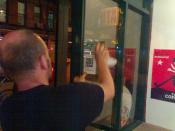IntroductionFaced with a loss of financing by his long standing family bank, as well as a 30 day deadline in which he must pay a $130,000 bank note, Jim Reed II, the owner of Reed's Clothier is now facing what he considers to be a monumental financial crisis. Inventory rich, but cash strapped, with only $85,000 in reserves, Jim must now quickly convert a large portion of his $491,000 inventory into cash, in order to meet his pending and future financial obligations.
Through the analysis of various financial ratios we will attempt to gain insight into how Jim Reed managed to find himself in his current dire predicament, as well as determine the means by which he might restore his family business to full financial health.
1. Calculate a few ratios and compare Reed's results with industry averages.
What do these ratios indicate?Financial ratios are a valuable and easy way to interpret the numbers found in statements.
It can help to answer critical questions such as whether the business is carrying excess debt or inventory, whether customers are paying according to terms, whether the operating expenses are too high and whether the company assets are being used properly to generate income.
When computing financial relationships, a good indication of the company's financial strengths and weaknesses becomes clear. Examining these ratios over time provides some insight as to how effectively the business is being operated.
In comparing the financial ratios of Reed's Clothiers to the averages of others in the same industry, it readily becomes clear that Jim's preference of keeping a large inventory of clothing on hand was definitely having a negative impact on his business.
Reed's Clothiers inventory turnover ratio of 2.9 is extremely low in comparison to the industry average of 7.0. Also Reed's Clothiers quick ratio is...


